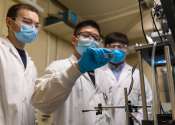Computer scientists create programmable self-assembling DNA
Computer scientists at University of California, Davis, Maynooth University in Ireland and the California Institute of Technology have created DNA molecules that can self-assemble into patterns essentially by running their ...
Mar 20, 2019
0
1728









